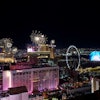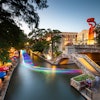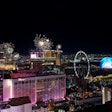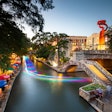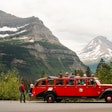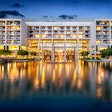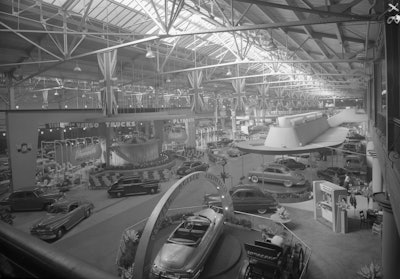
It's likely you've booked or attended a show at a convention center and didn't give a second thought to its backstory. Although countless convention centers around North America are modern marvels, there are many venues that have been around for close to 100 years. They serve as architectural spectacles and have witnessed pivotal moments in history, proving they're more than just places to convene.
Below, we share the backstories of six convention centers in the U.S. (and one in Canada), from what was once the largest railroad station in the southern U.S. to a facility that has preserved a section of the Underground Railroad. That way, the next time a trade show or conference brings you to one of these convention centers, you can share a bit of its history with fellow conventiongoers.
 Did you know that the Beanfield Centre's south side (pictured) was originally the main entrance, rather than the current north entrance? The trees and lawns located there now create a hidden oasis on the Exhibition Place grounds.Photo: Exhibition Place Archives
Did you know that the Beanfield Centre's south side (pictured) was originally the main entrance, rather than the current north entrance? The trees and lawns located there now create a hidden oasis on the Exhibition Place grounds.Photo: Exhibition Place Archives
1. Beanfield Centre at Exhibition Place | Toronto
Formerly known as the Automotive Building, this heritage building was built in the 1920s on Exhibition Place's expansive campus because of burgeoning interest in automobiles. Designed by Toronto architect Douglas Kertland, the building opened in 1929 and hosted the National Motor Show exhibit of automobiles until 1967. During World War II, the Royal Canadian Navy used the building and named it HMCS York. The building was restored in 2008, and special care was taken to preserve the art deco architecture while modernizing it for LEED Silver designation.Records and archives supervisor Fiona Crawford's favorite fact about the Beanfield Centre? "South of the building was originally the main entrance, rather than the current north entrance," she says. "The trees and lawns located there now create a hidden oasis on the Exhibition Place grounds where visitors can get a sense of the building’s original relationship to the site and Lake Ontario."
 Today, the Prime maintains some of its historical features.Photo: Courtesy of Prime F. Osborn III Convention Center
Today, the Prime maintains some of its historical features.Photo: Courtesy of Prime F. Osborn III Convention Center
2. Prime F. Osborn III Convention Center | Jacksonville, Fla.
What is now known as the Prime F. Osborn III Convention Center originally opened in 1919 as the largest railroad station in the South, the Jacksonville Union Terminal. It featured more than two dozen rail tracks, a restaurant, a gift shop, and other amenities. Today, the Prime maintains some of its historical features, including a retired railcar, train bumpers, and signage. The station was last used on Jan. 3, 1974; the convention center as it is today opened on Oct. 17, 1986."The train station operated for 55 years, with the peak of its passenger travel during World War II," says Jim Pritchard, director of the convention center. "As many as 100,000 servicemen and civilians passed through on the busiest days."
 At the Lancaster County Convention Center, visitors can view the preservation process behind glass on the lower level.Photo: Courtesy of Lancaster County Convention Center
At the Lancaster County Convention Center, visitors can view the preservation process behind glass on the lower level.Photo: Courtesy of Lancaster County Convention Center
3. Lancaster County Convention Center | Lancaster, Pa.
It's no surprise that the convention center in Pennsylvania's Lancaster County—one of the oldest inland cities in America—has an interesting historical story to share. The Lancaster County Convention Center boasts a number of historical features, but the most compelling? It features an official site and preserved section of the Underground Railroad. The Thaddeus Stevens & Lydia Hamilton Smith Center for History and Democracy is the historic site and former home and business of anti-slavery and pre-Civil War congressman Thaddeus Stevens.Currently in development, the historic site will transition into a museum and share the story of these two noteworthy Americans, while exploring the quest for freedom among enslaved African Americans and the pivotal place that Lancaster, and the surrounding region, played in the operation of the Underground Railroad. The museum is projected to open in late 2025. In the meantime, visitors can view the preservation process behind glass on the lower level of the convention center.
“The historical features on site here at the Lancaster County Convention Center and Lancaster Marriott provide a unique and elevated experience for our meetings, conference, and convention attendees, and the completion of the Thaddeus Stevens & Lydia Hamilton Smith Center for History and Democracy is only going to enhance this experience," says Hans Schreiber, director of sales and marketing for the Lancaster County Convention Center and Lancaster Marriott at Penn Square. "We look forward to hosting personalized group tours, private events, after-hours ‘History Happy Hours,’ and more."
 Jim Whelan Boardwalk Hall, located right on the famous Atlantic City Boardwalk, was the city's primary convention venue until the Atlantic City Convention Center opened in 1997.
Jim Whelan Boardwalk Hall, located right on the famous Atlantic City Boardwalk, was the city's primary convention venue until the Atlantic City Convention Center opened in 1997.
4. Jim Whelan Boardwalk Hall | Atlantic City, N.J.
Formerly known as the Atlantic City Convention Hall, Jim Whelan Boardwalk Hall was built in 1929 to host the city’s growing convention industry. With a large 137-foot-high barrel vault ceiling, it laid claim to the world’s largest clear-span space during that period. It's still known for a number of "firsts." In 1930, it hosted the nation’s first indoor college football game; in 1940, it became the home of the Miss America Pageant; from July 1942 until November 16, 1945, the Army Air Forces used it as a headquarters and training facility during World War II; and in 1964, the venue housed more than 20,000 visitors for the 1964 Democratic National Convention. It was the city's primary convention venue until the Atlantic City Convention Center opened in 1997. Today, Boardwalk Hall hosts a variety of entertainment acts and musical artists. The Lake Placid Conference Center is pictured here in the foreground on the right. The light brown brick building in the middle is the façade of the 1932 Olympic ice arena. The large white curved dome is the 1980 Olympic arena.
The Lake Placid Conference Center is pictured here in the foreground on the right. The light brown brick building in the middle is the façade of the 1932 Olympic ice arena. The large white curved dome is the 1980 Olympic arena.
5. Lake Placid Conference Center | Lake Placid, N.Y.
If you're a fan of the movie Miracle, this one's for you. The Lake Placid Conference Center sits adjacent, and is physically connected to, the Olympic arenas that hosted the 1932 and 1980 Winter Olympic games. (Lake Placid is one of only three destinations that has welcomed the Winter Olympics twice.) The 1980 games, of course, were famous for many reasons, but especially for the U.S. hockey team's win over Russia with just seconds to go. Dubbed the "Miracle on Ice," the game is often regarded as one of the greatest moments in sports history.Conference attendees in Lake Placid can tour the Olympic Center, along with many of the other Olympic venues, or simply walk Main Street for a sense of Olympic history in the small town of Lake Placid. Planners can book the ice space for events for a unique experience without having to leave the building.
 New Orleans Ernest N. Morial Convention Center served as the 1984 Louisiana World Exposition's 300,000-square-foot Great Hall, which hosted many of the event's state and corporate exhibits.Photo: Courtesy of New Orleans Ernest N. Morial Convention Center
New Orleans Ernest N. Morial Convention Center served as the 1984 Louisiana World Exposition's 300,000-square-foot Great Hall, which hosted many of the event's state and corporate exhibits.Photo: Courtesy of New Orleans Ernest N. Morial Convention Center
